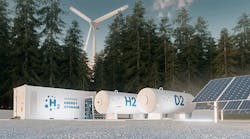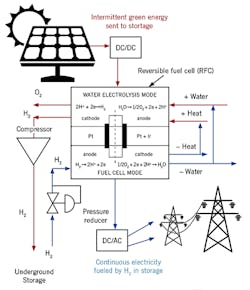When the world's leaders held their 26th U.N. Climate Change Conference in Glasgow, they demonstrated that they care only about the next election, that they can't shake off complacency or stop living in delusion, and can't start caring about coming generations. They're just passing the buck by saying, “What did future generations ever do for us?" Yes, our leaders are emitting only hot air, but individuals and corporations are rolling up their sleeves, as demonstrated by the construction of 10,000 "net zero" homes in the U.S. and by Boeing’s 777X that will fly on hydrogen.
Still, I'm convinced it's only a question of time until we stop burning fossil fuels, and replace them with green energy sources such as solar-hydrogen. The role of hydrogen is essential because most green energy sources are intermittent, and have to be converted into continuous ones to be stored and transported. This will be done with high-pressure hydrogen.
Hydrogen is needed because batteries are no good for applications like the Boeing airplane, which would need 7 million pounds of batteries to fuel an overseas flight. I know our automation and control profession will play a critical role in this transition, and this is the reason ISA is publishing my book that describes the role of multivariable controls supported by artificial intelligence (AI) and the measurement, control and optimization requirements of this new, solar-hydrogen technology that will make solar energy continuously available.
The green power plant
Figure 1: Fleets of these power plants will be fueled by free and inexhaustible solar energy and their production will be made continuous by underground cave storage of hydrogen.
Green power plants of 1,000 MW or larger (shown in Figure 1) are likely to replace the present fossil and nuclear power plants in the next few decades. In future columns, I plan to discuss the control and optimization of this new fixture in the sustainable landscape. Such plants can be viewed as artificial forests because they do much the same thing as trees do: use solar energy and water from the ground to produce oxygen and food-energy for us.
When a solar farm generates more electricity than users demand, a reversible fuel cell (RFC) operates in its electrolyzer mode (red path), storing the excess energy in the form of hydrogen in underground caverns (can be depleted oil or natural gas caverns). And when the demand on the grid is more than that what the solar farm generates, the RFC switches into its fuel-cell mode (blue path), taking the hydrogen from storage in the cave to make up the difference. Once the construction of the power plant is financed, its fuel is free, and its building and operation will provide more jobs than the fossil power plants it replaces.
The solar panels shown stand for any type or size of green energy source (solar, wind, hydraulic, ocean, geothermal, etc.), and if no electric grid exists in the area or if the users are at a large distance, the energy can be transported similarly as natural gas is today (either in liquid or high-pressure gas form). Such power plants don't exist today (only in my head), but "grey" hydrogen (hydrogen from hydrocarbons) is being widely used in industry, space exploration and transportation. Here I'll describe some of these existing applications.
Today, we use mostly grey hydrogen. The electrolyzer and the fuel cell paths aren't yet combined into RFCs, and hydrogen is mostly produced with proton-exchange membrane (PEM) designs. The electrolyzers are available for low- or high-pressure operation in sizes up to 10 MW. Their efficiencies range from 50% to 80%, and to generate 1 kg of hydrogen, they require 50 to 80 kWh of solar electricity. Each kilogram of hydrogen has an energy content of about 40 kWh/kg (approximately the same as a gallon of gasoline). In addition, most fuel-cell operated electric vehicles (FCEV) presently carry a minimum of 5 kg of hydrogen at 700 bar (trucks carry 16 kg), and their storage tanks require three to four times the volume of a gasoline fuel tank to cover 300 miles (500 kilometers) of driving distance.
At 8 cents/kWh, the generation of grey hydrogen costs from $4.0 to $6.5 per kg. At the hydrogen fuel stations in California, one has to pay about $16/kg for grey hydrogen. The U.S. Dept. of Energy (DOE) estimates that by 2030, the cost of green hydrogen would have to drop to $2 to $3/kg and the Biden administration is talking about $1/kg by 2032.
Hydrogen storage advances
In fuel cell cars or private home applications, small, well-proven storage tanks are used. Hydrogen is usually stored so that any leakage would easily escape into the atmosphere, such as with today's propane tanks. Indoors, if hydrogen is allowed to accumulate to over 5% concentration it becomes a potentially explosive mixture. In family home applications, a 5 kg hydrogen tank outside the home can meet the electricity needs of an average home (including its electric car) for one week. Plus, it can meet the home’s hot water or space-heating needs and generate distilled water if the household needs it.
The reliability of these tanks has improved much over the past decades. They've been dropped from drones, fired at, tested at up to 1,400 bar overpressures and found safer than gasoline tanks. Compressed hydrogen fuel tanks are now made of carbon-fiber composites or carbon fiber and metal alloys and composites. The inner liner of the tank is a high-molecular weight polymer that serves as a hydrogen gas permeation barrier. The outer shell is placed on the tank for impact and damage resistance. A pressure regulator and relief devices plus in-tank gas temperature sensors are provided to monitor the pressure and temperature during the gas-filling process. Elegant, compact and accurate instrumentation has been developed for these high-pressure hydrogen applications.
These in-tank regulators illustrate the uniqueness, elegance and importance of the contributions our profession (and only our profession) can make by designing the components for this new technology of the future.
In my next column, I'll describe some of the sensors, valves and control systems being developed or that have already been designed to meet the needs of the coming solar-hydrogen energy economy. I believe the coming decades will not only convert our physical environment, but AI will also change our cultural environment and the control strategies we've developed for industrial processes will become essential and irreplaceable.







